MocDoc's Offerings
A note from our CEO, Senthil Kumar.
Published By
Senthil
2020032214:10:30
Category Healthcare
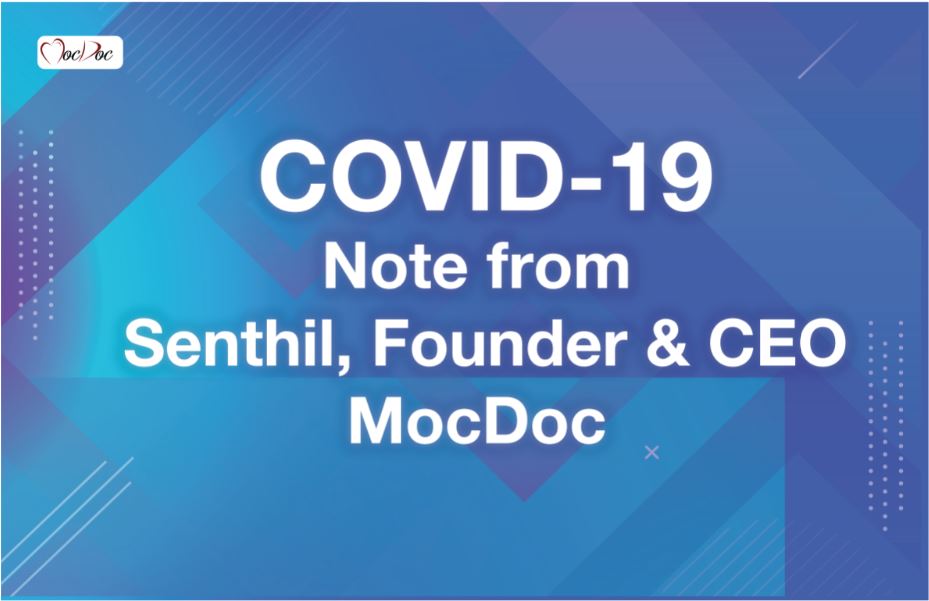
COVID-19 Update:
Message to our MocDoc Community,
Like you, we are also following the updates about COVID-19 with the concern of the national well-being, Our thoughts are with those who have been impacted by the virus and we wish them a full and speedy recovery.
As concerns on the recent outbreak of COVID-19, we're reaching out with a brief update to let you know how MocDoc is planning and preparing to provide uninterrupted support and service to our clients during this time.
Thank you for your understanding and for supporting us during this period. Stay safe and look out for those around you.
We are in this together, we will overcome it together!
On behalf of everyone at MocDoc,
Senthil
Founder & CEO,
MocDoc, a product of Yro Systems Pvt Ltd.
Related Articles
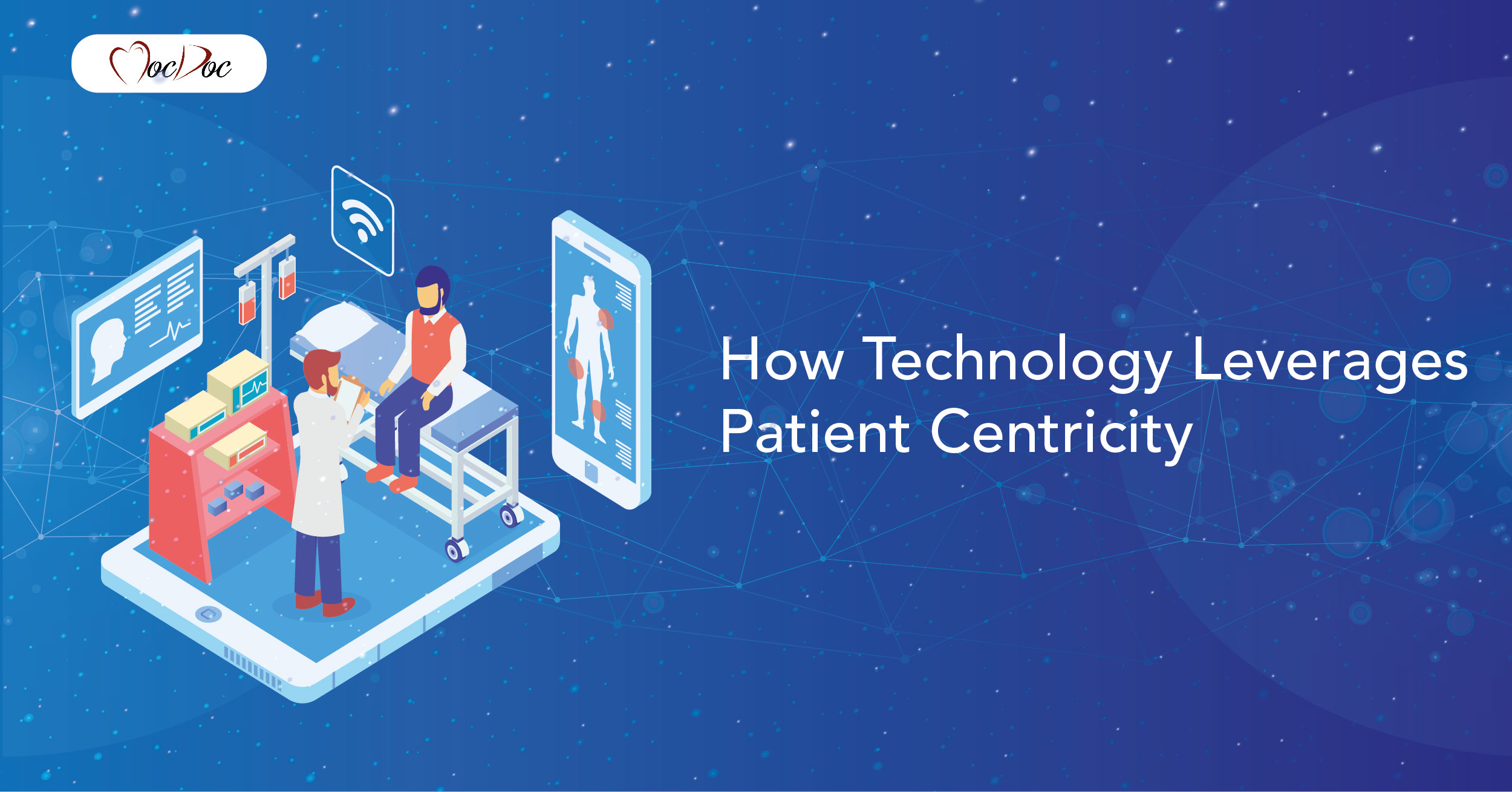
Imagine the following scenarios:
An electrocardiogram necklace that helps the physician track the patient’s health.
A chip in a pill is used for sending data to a web portal from the body and also the capability of your doctor to check the patient’s treatment progress.
A fetal monitoring device that observes the women remotely with pregnancies of higher risks.
The above are some of the visuals which can happen in the future of Healthcare and medicine. These types of unsetting technologies are redefining the patient experience and transforming outcomes in the clinics of the healthcare industry. Different data points show this effective modification. The life expectancy has increased to 60 years from 30 years between 1800 and 2000 at 1.5 years average rate per decade. The likelihood has now expected to be 90 years by the end of 2020 and at a 15 years per decade average or 10 times faster than that and this is what we call a Patient centricity world. In this blog, we will check out patient-centricity in-depth and how technology is used to enhance them.
What is Patient Centricity?
There are three significant aspects when it comes to defining patient centricity. Let’s check them below.
Making use of patient data efficiently for better treatment, monitoring, diagnosis, and R&D. At present, the evidence in the real world is reliably becoming significant, especially in the FDA providing new drug approvals. Correspondingly, the CMS (Centers for Medicare and Medicaid Services) is increasingly accomplishing providers to prefer measures and address outcome data via the execution of the meaningful use regime.
Patient Centricity also deals with improving patient experience and engagement to mold them into active attendants in every decision that is care-related and also enhances the excellent patient experience. The trend has now moved to human clinical trials, especially during the drug development’s advanced stages to engage patients actively.
Patient Centricity helps to enhance the outcome of the patient by shifting the focus to a population health management approach to individual encountering that targets interferences on particular cohorts and holistically at the patient risk.
Digital technologies can be influenced by Healthcare Software and Life science organization to allow patient centricity in a way that creates excellent health outcomes, transform the patient experience, and the boom line, and also boost customer loyalty.
Data encourages Customer Insights:
Enhancing the patient experience takes more time than expanding technologies and also needs data-driven insights. Data is the only fuel that powers an enterprise’s patient-centric strategies. Device data, inventory data, customer data, systems data, etc. offer a 360-degree view which forms the substratum of patient-centric decision-making, sound, and process optimization.
The ability to define more information and in-depth insight is vital for discerning the health journey of the patient and developing outstanding experiences. When you apply AI to the data wealth, Healthcare and life science organizations can expand their understanding of the expectations and experiences of the patient. With this knowledge, they can enhance app features and interfaces, offer customized and individualized experiences, and streamline the process at every point along the journey of the patient.
The combination is Key:
All the technologies and digital data in the world will do little to enhance the experience of the patient in case they do not work in concerts. There is an entirely expandable digital platform that supports the complete journey of the patient, and this is mandatory to offer an outstanding experience.
Adequate healthcare and life sciences amid digital platforms are rooted in a simple, user-friendly, and intuitive design which makes it easy for both healthcare professionals and patients to communicate, share, and access data along with various systems and also initiate actions. These management tools and platforms that include automation enable healthcare and life science enterprises to influence athletic abilities across the enterprises.
Support staff and clinicians can communicate with patients and colleagues in real-time and remotely, the people in the group can reply to the requirements, collaborate rapidly on new services and products, and enterprises can more rapidly take the opportunities advantages.
The healthcare and life science system which efficiently utilizes digital technologies and data to enhance the experience of the patient is OSF Healthcare which analyzes and expands internal and external social, financial, clinical, and operational data to improve the organization and patients. This information is daily updated, enabling OSF to execute new processes and monitor real-time bed availability.
The truth is that OSF can enhance capacity management and efficiency, decrease readmissions by offering physicians a readmission risk score of their people each day, and also gain the insight advantages coming to the system, allowing rapid discussions that focus on the patient requirements.
Bottom Line:
To achieve strong patient-centricity, Healthcare and life science need to expand digital tools and platforms in a way that enhances processes and people to deliver the best goals as per the customer requirements. The technology is required to function as the best part of this type by connecting customer knowledge, facilitating data collection, empowering responsiveness, innovation, and more. It can also play an essential role in operationalizing feedback and measuring performance to make sure the strategies in customer-centric approaches are on track and also can be adapted continually to deliver new value.
By exploring the unique customer experience and organizing processes, technology, and teams to deliver on the vision consistently, different health enterprises can lead in the present patient-driven market successfully.
To know More Visit The Complete Digital Healthcare Solution MocDoc.
How Technology Leverages Patie...
Imagine the following scenarios: An electroca..... Read more
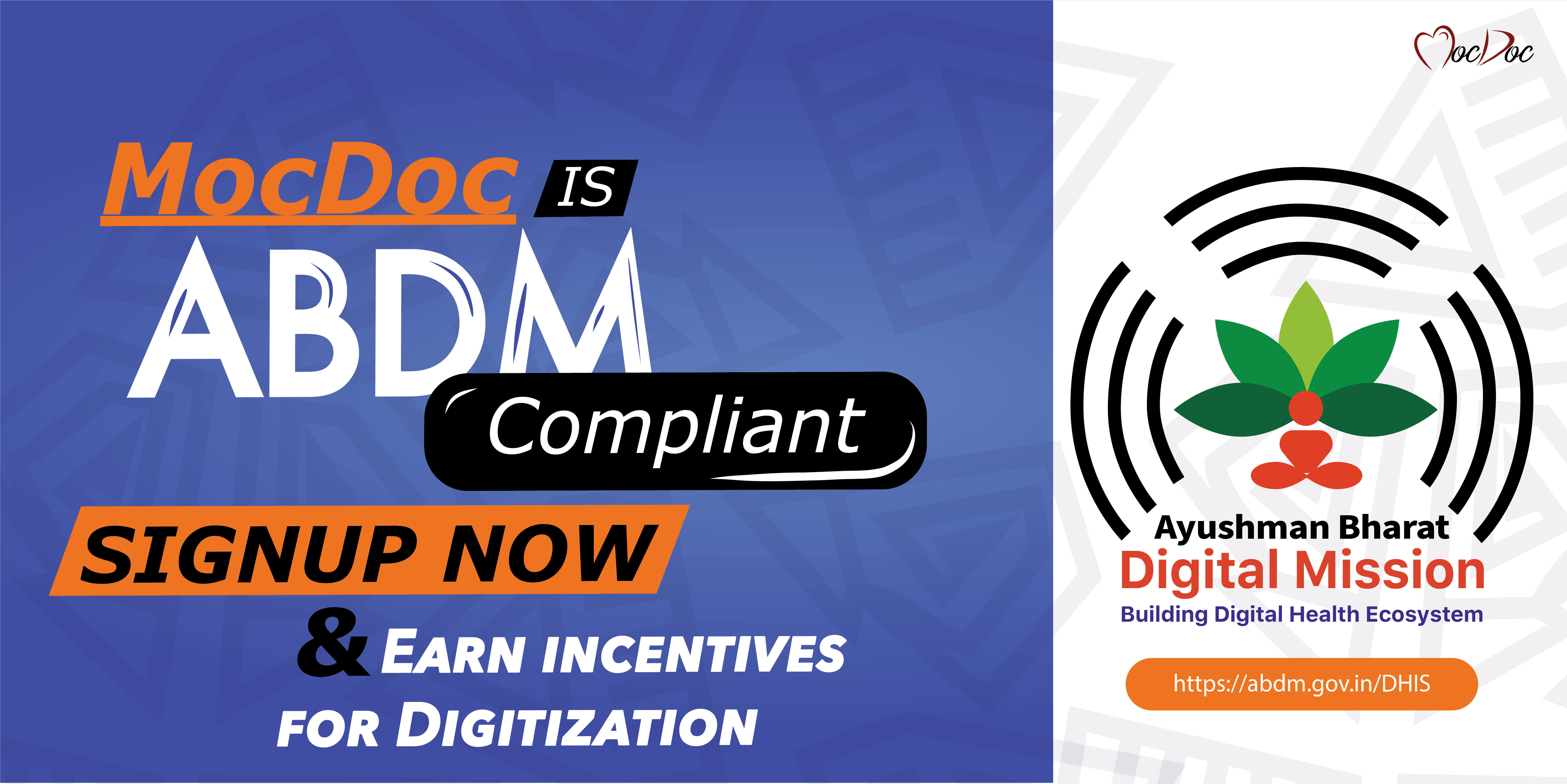
Introducing Ayushman Bharat Di...
Ayushman Bharat Digital Mission (ABDM) Th..... Read more
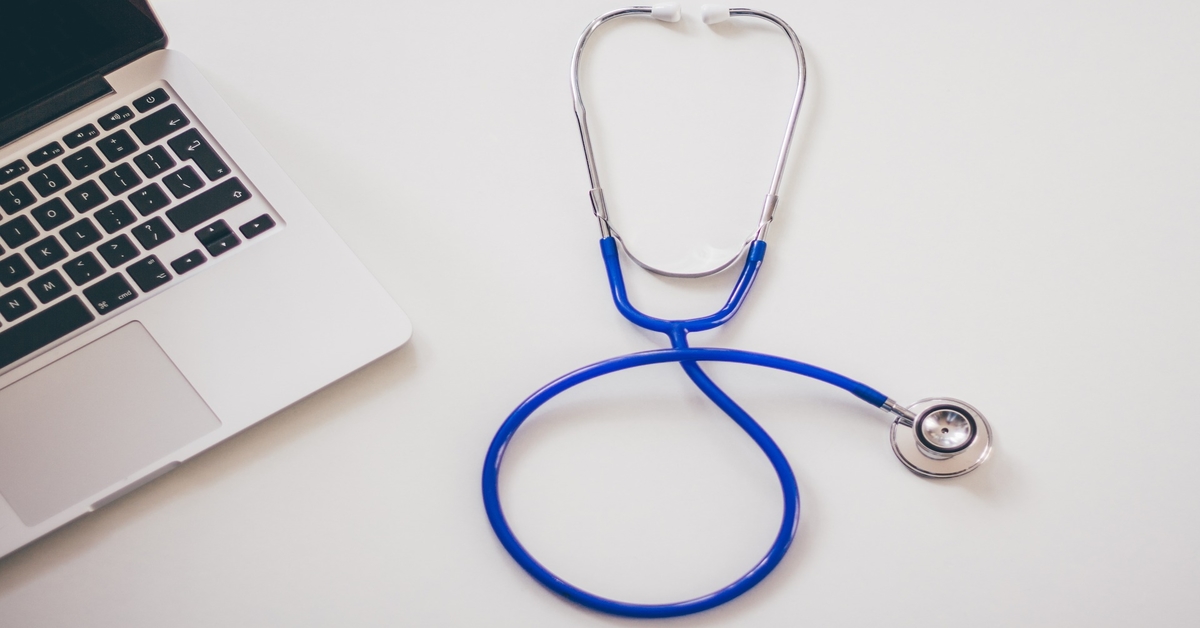
The healthcare sector is facing pressure to move to digital systems, both from regulatory authorities and from the general public. The government is pushing for digital systems so as to make the functioning of hospitals and other healthcare systems more transparent. The public is becoming more aware of their healthcare requirements and options and is demanding more efficient and accessible healthcare systems, and the healthcare providers are becoming more aware of this need. Many healthcare IT firms are trying to fulfill this need, and are providing a variety of software services. Let’s try to understand the different types of healthcare software used by various healthcare providers.
EHR
Electronic health records or EHRs are used for storing patient information in a digital manner. It is used by hospitals and clinics to store the complete medical history of a patient. Government health regulators in many countries are moving forward with plans to make electronic health records mandatory.
These records provide a secure and easily accessible way of storing medical records compared to paper-based records. Electronic records do not have the risk of loss of medical history or being illegible or destroyed over a long period of time. It also prevents duplication of medical records, since there is only one file that is modified over time.
Electronic health record software is used in both clinics and hospitals and usually comes integrated with hospital management software and practice management software.
Practice management software ( PMS)
Practice management software or clinic management software is used for managing clinics. Depending on the requirement of the clinic, software with various combinations of features is available. Generally, they contain appointment management, billing, and electronic health records. Software with integrated lab and pharmacy management features is also available if there are labs or pharmacies associated with the clinic. Practice management software helps to streamline the workflow of a clinic, gets error-free documentation, manages appointments and billing, and makes the system more efficient.
Specialized systems are available for dental care, ophthalmology, and other specialty clinics, with customized prescription management and health records.
Queues in the clinic can also be managed by the system, either on the basis of tokens or on the basis of appointments
Hospital Management System ( HMS )
Hospital management system has almost all the features described above, and more. They are a fully integrated system capable of managing the entire hospital. They are capable of managing appointments and electronic health records for both inpatient and outpatient departments. They are used for managing doctors’ schedules, surgeries, other procedures, and all the aspects related to them. They are also capable of handling the labs and pharmacies attached to the hospitals. The HMS systems can also manage the rooms, marking rooms as occupied, unoccupied, undergoing maintenance, etc, making it easy to allocate rooms and beds for patients.
Hospital management systems are often linked to the websites of the hospitals and patients can use them to book their appointments, get access to their health records and treatment plans, and manage their prescriptions. These days they also come with apps for patients that aid the patients in these same tasks much more easily through their smartphones. Alerts are provided through SMS services for follow-up procedures, vaccinations, etc in some hospital management systems.
Due to the integrated nature of the HMS, all the procedures done in various departments of the hospitals, all the tests done, medicines administered, and prescribed are tracked, thus allowing easy comprehensive billing.
Laboratory information management systems ( LIMS )
Lab information management systems, as the name implies, are used to manage the functions of a lab. It will have provisions for sample collection, inventory management, accounting functions, and provisions for machine interfacing with the lab equipment.
A good lab information system will provide full automation and ensure error-free results, with alerts for abnormal results. With machine interfacing, data from the instruments in the lab are directly read by the software, and accurate records are made against the sample data. In the case of LIMS systems integrated with the hospital management system, provisions may be there to add the test results to the patient records. Stand-alone systems are also available for use by independent laboratories.
The Laboratory information management system helps lab technicians to achieve a smooth workflow and better quality control. From the point at which the sample is collected, till the results are delivered, samples are tracked using the software, which means that any technician in the lab can find out what to do with a sample at every step of the way, thus avoiding issues with sample management. The system also prevents errors, thus improving the credibility of the lab.
Billing software
Billing software has been used as part of hospitals and clinics ever since accounting went digital. Even before EHRs came, accounting software was being used in many hospitals.
Billing software helps to manage insurance claims and provides a smooth accounting of medical bills. The entire medical costs of all the patients can be easily accessed and organized in an efficient manner using billing software. Though they come along with hospital and practice management systems these days, they are still available as stand-alone systems.
What are the different types o...
The healthcare sector is facing pressure to move t..... Read more
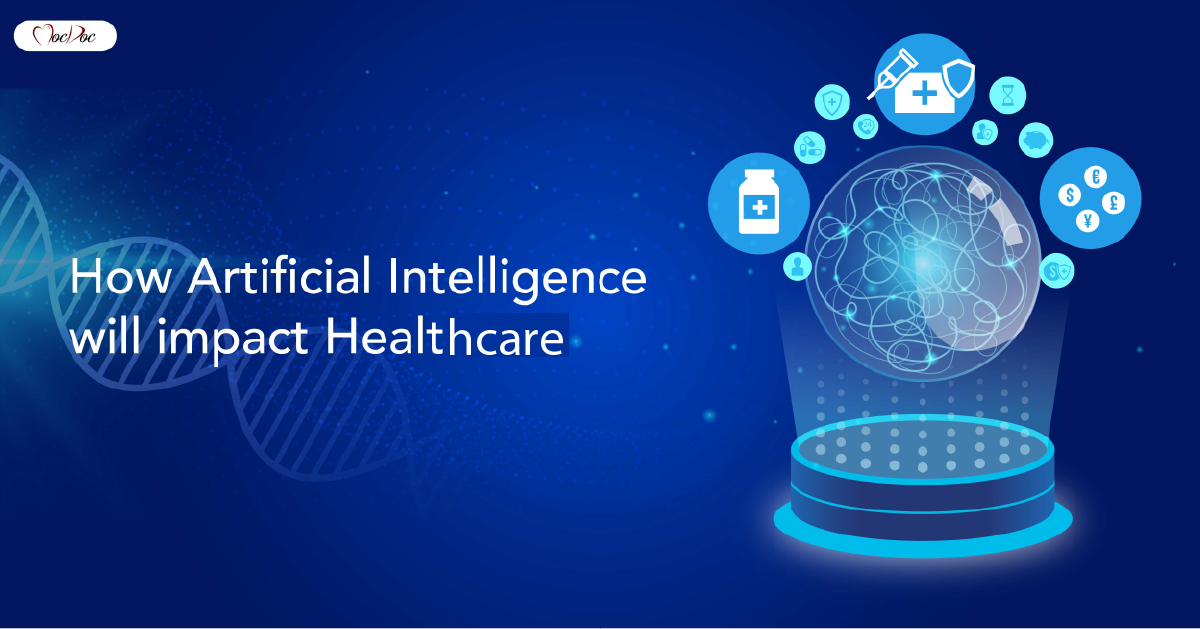
The healthcare industry has started to see considerable changes in the past few years. From cancer and chronic diseases to risk assessment and radiology, there are multiple opportunities to influence technology. It is used to implement more effective, impactful, and precise interferences at the right moment in taking care of the patients.
Artificial Intelligence acts as the central aspect, which drives enhancement across patient care. AI provides many advantages over other clinical decision-making techniques and traditional analytics. Getting to know algorithms can become more accurate and precise. It is because they allow humans to gain insights into diagnostics, and interact with training data, treatment variability, care processes, and patient outcomes.
8 Ways AI Impacts Healthcare:
Proceed below to find out some practical ways in which AI changes the healthcare industry.
1. Integrating Machine and Mind using Brain-Computer medium:
Utilizing systems to collaborate is not a unique idea. However making direct communication between humans and technology without any requirements for monitors, mice, and keyboards is considered to be an essential area of research with a significant application for several patients.
Trauma and Neurological diseases to the nervous system may take away the abilities of patients like moving, interacting, and speaking meaningfully with the surroundings of people. BCIs (Brain-Computer mediums backed by AI can restore the primary experiences.
It's easy to decode the activities of the neural system affiliated with the purposive moment of one by utilizing AI and BCI. We can enable the person to collaborate the same way as different people work four to five times across the morning course. The communications are processed with the phone, computer, tablet, or using other universal communication technology. The medium of Brain-Computer helps to increase the quality of patient life with locked-in syndrome, strokes, ALS, spinal cord injuries, and more.
2. Producing the next generation of tools in Radiology:
The images of Radiology acquired by X-rays, CT scanners, and MRI machines provide non-intrusive reflectivity into the human body's inner workings. But many processes in diagnosing depend on the biopsies' physical tissue samples, which carry a risk that includes the infection potential.
According to experts, AI helps the next generation of tools in Radiology that are detailed and accurate to rebuild the requirements for tissue samples. Providers also can target the treatments and define the cancer aggressiveness appropriately. AI helps to make use of virtual biopsies and progress the intuitive field of radiomics that deal with utilizing image-based algorithms to represent the tumors' genetic properties and phenotypes.
3. Extending access to care in developing or underserved regions:
The lack of professional healthcare providers like radiologists and ultrasound technicians can constrain access to critical care in developing nations across the globe. AI enables mitigating the cause of a severe deficit of professional clinical staff by handling different duties that are provided to humans.
4. Decreasing the problems of using Electronic Health Records:
Electronic Health Record has a significant role in the industry of healthcare journey into digital recording. However, the switch comes with numerous issues affiliated with user burnout, endless documentation, and cognitive overload. The developers of Electronic Medical Records are now making use of Artificial Intelligence to develop more new interfaces. It also automates several processes in a routine which consumes the user's time.
All users spend their time on three crucial processes, namely sorting through the right thing, order entry, and clinical documentation. Dictation and voice recognition help to enhance the process of clinical documents, but NLP (Natural Language Processing) tools are not suitable for it. AI also helps to take care of routine requests like result notifications, and medication refills from the inbox. It also enables to make use of the tasks that severely need the attention of the client.
5. Comprising the Antibiotic Resistance risks:
Antibiotic Resistance is a threat that grows huge across the globe due to the overuse of drugs. Multi-drug resistance organisms can make a massive change in the hospital setting and also claim various numbers of lives every year.
Electronic Health Record information can help in highlighting the patient's problems and identifying the patterns in infection before they develop to show symptoms. Influencing AI and machine learning tools to drive all these analytics can create more accurate, faster alerts, and also improve their accuracy for healthcare providers.
6. Make accurate analytics for Pathology images:
According to Jeffrey Golden, Professor of Pathology at HMS and MD, Chair of the Pathology Department at BWH and Pathologist acts as the crucial diagnostic data source for providers across the care delivery spectrum.
70% of all healthcare decisions depend on the pathology results. AI also enhances productivity by finding out the features of interest in slides. AI is capable of screening through the slides and then directed to the right path to look, so it's easy to assess what is significant. It helps to enhance the effectiveness of the pathologist's use and improve the time value they spend on every case.
7. Admitting Intelligence to Machines and Medical Devices:
Smart devices provide everything from the refrigerator to real-time video to cars, which can detect when the driver gets distracted. Smart devices are essential for taking care of the patients in the ICU.
Artificial Intelligence helps to improve the ability to suggest Sepsis, identify degradation, and sense the complication development. The reason is that it can enhance the outcome significantly. It also decreases the cost related to penalties in clinic-obtained conditions. Making use of intelligent algorithms in smart devices can reduce problems for physicians and doctors while making sure that patients receive care at the right time possible.
8. Progress Immunotherapy usage for the treatment of cancer:
Immunotherapy is considered to be the critical avenue for cancer treatment. The therapy makes use of the immune system in the body to attack malice. In this case, patients can beat difficult tumors. The fact is that fewer patients get the advantage of immunotherapy. Oncologists do not have a reliable and precise method for recognizing which patient can gain with this immunotherapy. The algorithms of Machine learning and their ability to utilize different datasets illuminate unique options for exploiting therapies for a single genetic makeup.
Bottom Line:
Apart from the above impacts, there are several factors like
· Utilizing EHR as a precision risk predictor,
· Taking care of the patient's health through personal devices and wearable,
· Turning smartphone selfies into a robust and useful diagnostic tool,
· Making clinical decisions using AI is one of them that can change the healthcare industry.
Empowering a new generation of systems and tools to make doctors more effective when delivering care, aware of nuances, and more likely to get rid of the problems. AI plays a vital role in bringing different breakthroughs in caring for patients and also in clinical qualityHow Artificial intelligence wi...
The healthcare industry has started to see conside..... Read more